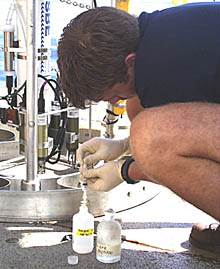|
|
TODAY'S WEATHER
Which ship -- and which project? Today’s work was a great example of how multidisciplinary (composed of many different branches of science) oceanography is! We have been analyzing the sonar and Argo II observational data we have collected during the past week, sampling rocks, collecting water samples from the diffuse flow hydrothermal field we discovered using Argo II, and even managed to collect a few biological samples in the dredge that dragged over the hydrothermal site. But have you ever thought about how scientists get to use the ships or the sophisticated deep submergence vehicles? It is not as if there are lots of ships and vehicles -- so who decides where the ships will work, and whose projects will be scheduled? There are three leading government agencies that support oceanography in the US: the National Science Foundation (NSF), National Oceanographic and Atmospheric Administration (NOAA), and the US Navy’s Office of Naval Research (ONR). The oceanographic research vessels, submersible and ROV systems, and other oceanographic facilities that scientists need to do their research are part of a national facility that is shared by all researchers. The government agencies provide funds to the University National Oceanographic Laboratories System (UNOLS), which is a consortium of universities and institutions that have focused programs in oceanography. Part of their job is to decide which ships will work in different areas, and how the different projects will be scheduled to maximize the use of the ships, and to make them cost-efficient. The best way to do that is to schedule a series of different projects one after the other that all require the ship to be in one geographic area -- in this case, the Eastern Pacific. That means that, even though I am based at Woods Hole Oceanographic Institution, which operates some of the UNOLS research ships, my cruises are often scheduled on other ships that are working in the area I want to go. That is the case for this expedition! UNOLS scheduled our cruise on the RV Melville which is operated by Scripps Institution of Oceanography. Apart from ships, the other part of the scheduling puzzle is getting the deep submergence vehicles to the right ship at the right time! Woods Hole Oceanographic Institution runs the National Deep Submergence Facility (NDSF) for UNOLS. The NDSF operates Alvin, the remotely operated vehicle (ROV) Jason, Argo II, and the DSL-120 sonar system. So, for this expedition, WHOI provided Argo II and the DSL-120 sonar, and the technical team to operate them. At the end of our cruise, we will get off the ship in Manzanillo, and another group of scientists will get on. If that sounds complicated enough, remember that over 100 different research cruises occur each year in different oceans! Can you imagine how difficult it is to plan them all? UNOLS and the different ship and facility operators have been doing this splendidly for many years, which is one of the reasons why US scientists accomplish so much excellent oceanographic science. Without the support and hard work of all the people back on shore that help plan and provide for oceanographic expeditions, we could not do our field work and collect the data.
|
|||||||||||||||||||||||||||||||||||||||||||||||||||||||||||||||||||||||||||||||||||||||||||||||||||||||||||||||||||||||||||||||||||||||||||||||||||||||||||||||||||
© 2010 Dive and Discover™. Dive and Discover™ is a registered trademark of
Woods
Hole Oceanographic Institution




